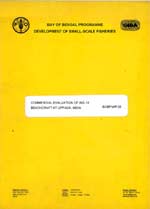
WORKING PAPERS - BOBP/WP/26
Commercial Evaluation Of Ind-13 Beachcraft At Uppada, India
by
R. Ravikumar
Fishing Craft Specialist, BOBP
 |
WORKING PAPERS - BOBP/WP/26 Commercial Evaluation Of Ind-13 Beachcraft At Uppada, Indiaby |
|
Executing Agency: FOOD AND AGRICULTURE ORGANIZATION OF THE UNITED NATIONS Funding Agency: SWEDISH INTERNATIONAL DEVELOPMENT AUTHORITY Development of Small-Scale Fisheries in the Bay of Bengal Madras, India, June 1984 |
| The designations employed and the presentation of material in this publication do not imply the expression of any opinion whatsoever on the part of the Food and Agriculture Organization of the United Nations concerning the legal status of any country, territory, city or area or of its authorities, or concerning the delimitation of its frontiers or boundaries. |
All rights reserved. Reproduction and dissemination of material in this information product for educational or other non-commercial purposes are authorized without any prior written permission from the copyright holders provided the source is fully acknowledged. Reproduction of material in this information product for resale or other commercial purposes is prohibited without written permission of the copyright holders. Applications for such permission should be addressed to the Chief, Publishing and Multimedia Service, Information Division, FAO, Viale delle Terme di Caracalla, 00100 Rome, Italy or by email to [email protected]
© FAO 2004
|
Traditional craft operating from open beaches account for the bulk of fish landings on the east coast of India. The difficulties of operating from surf-beaten beaches, the technical limitations of the existing craft and the constraints they put upon the expansion of the fishery and upon the scope for improvement in the wellbeing of the fishermen have been described many times. The requirements for a craftof better performance and economicpotential are, briefly, that the new craft should have a surf-crossing performance comparable to that of the traditional kattumaram, with a minimum tendency to broach and capsize; it should be strong enough to withstand heavy landings on surf-beaten beaches, but at the same time be capable of easy and quick handling up and down the beach; and it should provide more protection for crew and catch than existing craft. Most important, it should possess greatercarrying capacity and be able to operate at greater distances from the coast in order to increase the catching potential, and these various requirements must be met without incurring added costs of construction and operation that would absorb all of any increase in earnings thus achieved. The Bay of Bengal Programme designed and built a number of prototype beachcraft intended to meet these requirements and tested their surf-crossing and beachianding performance, as described in BOBP/WP/7: Technical Trials of Beachcraft Prototypes in India. The best of the orthodox boat designs, IND-13, wasselected for evaluation in commercial fishing conditions. This working paper describes the trials, and presents the results. |
1. INTRODUCTION
2. PLANNING AND CONDUCT OF TRIALS
2.1 The trial base
2.2 Arrangements for conduct of trials
2.3 Preliminary training
2.4 Operations and records
2.5 Supervision
3. CRAFT AND GEAR
3.1 The BOBP craft
3.2 Navas
3.3 The gear
4. RESULTS
4.1 Operations, costs and earnings
4.2 Technical assessment
4.3 Socio-economics
4.4 Performance of Navas during trial period
5. FOLLOW UP
5.1 Technical
5.2 Social
5.3 Economics
APPENDICES
Appendix 1. MAIN PARTICULARS
Appendix 2. GENERAL ARRANGEMENT OF THE NAVA
Appendix 3. SPECIFICATIONS OF NET USED FOR FISHING (UPPADA SURFACE DRIFTNET)
Appendix 4. GENERAL ARRANGEMENT OF IND-20
Appendix 5. ESTIMATES OF COSTS AND EARNINGS OF IND-20 BEACHCRAFT AND THE NAVA
PUBLICATIONS OF THE BAY OF BENGAL PROGRAMME